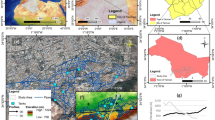Abstract
Geographical Information System (GIS) is used to assist Sydney Water, a state owned water utility, in their decision-making process to reduce the number of chokes occurring within their jurisdiction. The use of GIS enables Sydney Water to obtain easier visual interpretation of otherwise complicated and detailed raw data. GIS in this sewer choke analysis is found to be useful as it allows the spatial data to be correlated and helpful information e.g. the characteristics of the pipes to be symbolised accordingly. GIS can also be used to compute the extent of the area affected by concentrating on chokes occurring per region or on a grid basis. This let Sydney Water identify areas with high or low concentrations of sewer choke problems easily. Furthermore, queries can be run and data can be selected according to the user’s preferences. For example, users are able to query for data on chokes occurring due to a specific cause, such as tree roots ingression into the pipes, blockage by grease or debris, or pipe breakage. This study will hopefully assist Sydney Water in making quick and effective decisions for potential chokes according to the risk that they impose on the environment and population.
Similar content being viewed by others
References
Chang, N., Wei, Y. L., Tseng, C. C., and Kao, C.-Y. J. (1997). “The design of a GIS-based decision support system for chemical emergency preparedness and response in an urban environment.” Computers, Environment and Urban Systems, Vol. 21,Issue 1, pp. 67–94.
DeMers, M. (2005). Fundamentals of geographic information systems, 3rd Ed. John Wiley & Sons, pp. 233–237.
Frerichs, R. R. (2008). John snow, http://www.ph.ucla.edu/epi/snow.html, accessed online August 2008.
Jiang, B. (2007). “Editorial: Some thoughts on geospatial analysis and modeling.” Computers, Environment and Urban Systems, Vol. 31,Issue 5, pp. 478–480.
Khaemba, W. M. and Stein, A. (2000). “Use of GIS for a spatial and temporal analysis of Kenyan wildlife with generalised linear modeling.” International Journal of Geographical Information Science, Vol. 14, No. 8, pp. 833–853.
Sinclair Knight Merz (2005a). Dry weather overflow reduction strategy, June, 2005 Workshop Paper, Sinclair Knight Merz and Sydney Water.
Sinclair Knight Merz (2005b). Final draft sewer choke strategy, Report 2005, July, Sinclair Knight Merz and Sydney Water.
Sydney Water (2001). Fact sheet: Inspecting and fixing sewer pipes, December 2001.
Van Der Perk, M., Burema, J. R., Burrough, P. A., Gillett, A. G., and Van Der Meer, M. B. (2001). “A GIS-based environmental decision support system to assess the transfer of long-lived radiocaesium through food chains in areas contaminated by the Chernobyl accident.” International Journal of Geographical Information Science, Vol. 15, No. 1, pp. 43–64.
Vieux, B. (2001). Distributed hydrologic modeling using GIS (Volume 38), Kluwer Academic Publishers, Netherlands.
Wall, P. A. and Devine, O. J. (2000). “Interactive analysis of the spatial distribution of disease using a geographic information system.” Journal of Geographical Systems, Vol. 2, No. 3, pp. 243–256.
Wu, Y., Miller, H. J., and Hung, M. (2001). “A GIS-based decision support system for analysis of route choice in congested urban road networks.” Journal of Geographical Systems, Vol. 3, No. 1, pp. 3–24.
Author information
Authors and Affiliations
Corresponding author
Rights and permissions
About this article
Cite this article
Lim, S., Norzahari, F. & Lee, H. A GIS-based analysis of potential sewer choke in Western Sydney Region. KSCE J Civ Eng 14, 601–612 (2010). https://doi.org/10.1007/s12205-010-0601-y
Received:
Revised:
Accepted:
Published:
Issue Date:
DOI: https://doi.org/10.1007/s12205-010-0601-y




